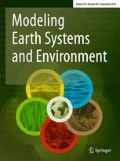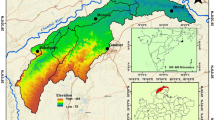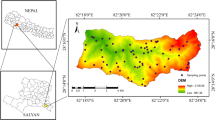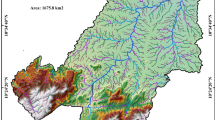Abstract
Soil erosion is one of the serious issues threatening the environment. This degrading phenomenon deteriorates the soil fertility and drastically affects the agricultural practices. As a consequence, the productivity of soil is affected unquestionably. In this regard, there is a need to take up conservation and management measures which can be applied to check further soil erosion. Even though, soil erosion is a mass process spread across the watershed, it is not economically viable to implement conservation techniques to the entire watershed. However, a method is a pre-requisite to identify the most vulnerable areas and quantify the soil erosion. In this context, Revised Universal Soil Loss Equation (RUSLE) has been adopted to estimate soil erosion in the semi-arid Andipatti Watershed of Tamil Nadu, India. This model takes into consideration the parameters including runoff-rainfall erosivity factor (R), soil erodability Factor (K), topographic factor (LS), cropping management factor (C), and support practice factor (P). All these layers are prepared in a geographical information system (GIS) platform using various data sources and data preparation methods. The results of the study indicate that the annual average soil loss within the watershed is about 6 t/ha/yr (metric ton per hectare per year). Higher soil erosion is observed in the landuse classes of gullied wasteland, open scrub forest and degraded plantation. The soil erosion risk is extremely higher on the steep slopes and adjoining foot hills. Based on the average soil erosion values of different landuse classes and characteristics of land, a proposed landuse map was prepared. The estimated soil erosion and the proposed landuse map could be an effective input for drawing sustainable watershed development measures.
Similar content being viewed by others
Introduction
Soil erosion assessment for sustainable development of watershed is a world-wide concern for landuse planners. Soil erosion, generally associated with agricultural practices in tropical and semi-arid regions, leads to decline in soil fertility and hence brings on a series of negative impacts to environment (Prasannakumar et al. 2012). Intensive cultivation and socio-economic pressure for more land have accelerated the rate of soil erosion on sloping lands (Shi et al. 2004). Since watershed forms a natural boundary to focus on all the effects of downhill runoff, a systematic assessment of soil erosion within the watershed would provide reliable information to draw strategies for sustainable development of watershed resources. The dominant model applied worldwide to estimate the soil erosion is Universal Soil Loss Equation (USLE), which is a conservation planning tool that has been demonstrated to do a reasonably good job for estimating soil erosion for many disturbed landuses (Moore and Wilson 1992; Millward and Mersey 1999). The USLE, a paper-based model, was computerized and updated by a group of scientists (Renard et al. 1997) and subsequently called as Revised Universal Soil Loss Equation (RUSLE). The RUSLE has been widely adopted for soil loss assessment at watershed scale because of its convenience in computation and application (Angima et al. 2003; Jain et al. 2001; Lu et al. 2004; Jasrotia and Singh 2006; Dabral et al. 2008; Kouli et al. 2009; Pandey et al. 2009; Bonilla et al. 2010; Saravanan et al. 2010; Renard et al. 2011; Sharma et al. 2011; Prasannakumar et al. 2012; Ranzi et al. 2012).
Choosing the data for variables of RUSLE and generating the layers for spatial assessment of soil erosion are critical tasks. However, geographical information system (GIS) has augmented the RUSLE and permits effective and accurate application of the model. Appreciable advancements in the application of GIS for preparing and analysing the thematic layers have taken place over the past several decades. Renschler et al. (1999) used RUSLE to predict the magnitude and spatial distribution of soil erosion using GIS software. Yang et al. (2003) employed a GIS-based RUSLE model to simulate global soil erosion. Shinde et al. (2011) applied RUSLE through GIS to quantitatively determine soil erosion and thereby prioritize micro-watersheds of upper Damodar Valley catchment.
With this background, the present study is carried out in Andipatti watershed of Tamil Nadu, India to estimate the spatial pattern of soil erosion using RUSLE and to find out the most vulnerable landuse classes. The objectives which are quintessential for the accomplishment of this study are to identify and evaluate the deciding parameters of the RUSLE, to collect and refine the relevant data from various sources, to prepare the corresponding thematic layers and overlay them using GIS to estimate the average annual soil loss and to identify vulnerable landuse classes of the study area.
Study area
Andipatti watershed is located in the Andipatti Taluk of Theni District in the state of Tamil Nadu. The watershed shown in Fig. 1 extends between the latitudes of 9°49′33′′ and 10°2′57′′ North and longitude of 77°31′47′′ and 77°39′20′′ East with an areal extent of 250 sq.km. The main hill range, located in the south and south eastern region of the study area, comprises of hard Archean crystalline formations and a large proportion of Charnockitc group of rocks. The central region of the study area has an expanse of Silimanite garnet gneiss. The southern and south-eastern part of the study area is covered with structural hills. The hilly region is observed with a few cliffs and escarpments. Alluvial fans and bajada covers the foothills of the hilly region. The plain area is dominated by pediments and buried pediments. Andipatti watershed enjoys a semi-arid climate with the average temperature varies between 19 and 36 °C and with an annual average rainfall of 768 mm. During the north-east monsoon season, the study area receives a major part of annual rainfall, particularly during October month with the highest share of rainfall. The monthly relative humidity varies between 54 and 68 %. The ephemeral Nagal Ar river and its tributaries originate from Andipatti southern hills of the Western Ghats and descend down along the slopes of the hills and enter the plains. All these streams flow towards northern direction and drains excess their water into the Vaigai river. The study area shows a gradual decrease in slope from south to north. The soil composition is highly heterogeneous and the soil orders of the study area are alfisols, inceptisols, mollisols and vertisols. A major portion of the watershed is used for agricultural purposes. Since the area is dominated by agrarian society, there are scattered settlements spread across.
Materials and methods
The RUSLE has been widely used to predict the average annual soil loss of a watershed by means of computing the soil erosion factors (Wischmeier and Smith 1978; Renard et al. 1997). The emergence of RUSLE has enabled the study of soil erosion, especially for conservation purposes, with effective and acceptable level of accuracy. Although it is an empirical model, it not only predicts erosion rates of ungauged watersheds using knowledge of watershed characteristics and local hydro-climatic conditions, but also presents the spatial heterogeneity of soil erosion that is too feasible with reasonable costs and with better accuracy in larger areas (Angima et al. 2003). The RUSLE model has the equation as follows;
where, A is the computed average soil loss over a period selected for R, usually on yearly basis (t ha−1 y−1); R is the rainfall-runoff erosivity factor (MJ mm ha−1 h −1 y−1); K is the soil erodability factor (t ha h ha−1 MJ−1 mm−1); LS is the slope length (L) and slope gradient (S) factor (dimensionless); C is the cropping management factor (dimensionless, ranging between 0 and 0.5); and P is the supporting conservation practice factor (dimensionless, ranging between 0 and 1). The quantitative evaluation of soil erosion loss by RUSLE is based on its component factors corresponding to each of the parameters of the equation.
In this study, GIS plays a major role in preparing thematic layers and estimating soil erosion. The rainfall data of 17 years (1996–2012), acquired from the State Surface and Groundwater Resources Data Centre, Chennai was used to estimate the mean annual rainfall and to prepare R factor. The soil map of the study area, surveyed and prepared by Tamil Nadu Agricultural University (TNAU), Coimbatore, was used to find out the K factor. With the help of Ground Control Points (GCP’s), the CARTOSAT stereo pairs (Feb, 2007) were rectified and triangulated for the preparation of Digital Elevation Model (DEM). Then the DEM was edited to prepare a new DEM with a 5 metre pixel size under stereo environment in Leica Photogrammetry Suite (LPS). After the 3D editing work, the DEM was used to prepare a slope map. The DEM and slope map were used later to obtain LS factor. The IRS LISS-IV and CARTOSAT satellite images were fused to prepare a detailed landuse/land cover (LULC) map using visual interpretation techniques based on National Remote Sensing Centre’s (NRSC) level II classification scheme. The scheme was slightly modified to fit the local conditions. The LULC map was subsequently used to assign the C factor and the P factor (Fig. 2).
Determining RUSLE factor values
The RUSLE is a set of mathematical equations that estimate average annual soil loss resulting from soil erosion. Derivation of values for RUSLE is well documented in the literatures (Wischmeier and Smith 1978; Renard et al. 1997). In the following sections, the values assigned to the RUSLE factors are discussed in detail.
Rainfall erosivity factor (R)
R is the long term annual average of the product of event rainfall kinetic energy and the maximum rainfall intensity in 30 min in mm per hour (Wischmeier and Smith 1978 ). Rainfall intensity represents the principal factor of kinetic energy and to estimate the rainfall erosivity, several empirical formulas have been developed for different regions of the world. In this study, the linear relationship established by Singh et al. (1981) and adopted by Parveen and Kumar (2012) was used to calculate the annual rainfall erosivity. The derived relationship is given below:
where RN is the average annual rainfall in mm. In this study, 17 year (1996–2012) average annual rainfall data has been used to calculate the average annual R factor values. Since only seven rainfall gauge stations are located in and around the study area, an interpolation of R-factor values is applied to have a representative rainfall erosivity map (Fig. 3). After several attempts of trail investigations, inverse distance weighted (IDW) interpolation technique was adopted in this study. The erosivity factor varies from 333.6 to 414.2 MJ ha/mm/hr/yr.
Soil erodability factor (K)
This factor conveys the rate at which different soils erode. Some soil types are naturally more prone to soil erosion due to their physical structure. Erodability is a function of soil texture, organic matter content and permeability. A nomograph prepared by Wischmeier and Smith (1978) is widely used to predict soil erodability factor. The analytical relationship for the expression is given by the following regression equation.
where OM is Organic Matter, s is structural code, p is permeability code and M is calculated as follows:
The s and p parameters describe soil structure and permeability, as defined in the Soil Survey Manual (USDA 1951) and M is the particle size parameter. By using the above equations, the K value (tons MJ−1 hmm−1) was computed and subsequently the K factor map was prepared (Fig. 5). This factor depends upon the soil composition and soil texture (Fig. 4) and it helps in the quantitative estimation of soil erosion and it conveys the ability/vulnerability to erode.
Slope length and steepness factor (LS)
Slope length and steepness factor (LS) accounts for the effect of topography on sheet and rill erosion. There are a number of methods available to find out LS and for the present study, two parameters that constitute the topographic factor, slope length and slope gradient factor, are estimated through a DEM. The present study employed the stereo triangulation for the preparation of DEM using CARTOSAT stereo pairs and 28 Ground Control Points (Fig. 6). With the help of DEM, the slope map was prepared (Fig. 7) and it was used to calculate LS factor. The LS is the expected ratio of soil loss per unit area from a field slope to that from a 22.13 m length of uniform 9 % slope under otherwise identical conditions (Shinde et al. 2011). A slope length map was generated using the equation as follows;
where L is the slope length and Sp is the slope steepness in percentage. For slopes up to 21 %, the following equation, modified by Wischmeier and Smith (1978), was used.
For slope steepness of 21 % or more, the equation used is:
where, LS2 is the slope length and gradient factor, θ is angle of the slope and L is slope length in metres.
Depending upon the slope steepness, two different LS factors were calculated using Eqs. (6) and (7) and both the values have been integrated to have a single LS map. The LS values of the study area are in the range of 0.008–22.12 and most of the study area falls in between 0 and 2 (Fig. 8).
Cropping management factor (C)
Cropping management factor (C) represents the combined effect of soil disturbing activities and mostly reflect the effect of cropping and management practices on erosion rates. The C factor is based on the concept of an area deviation from the clean-tilled continuous fallow conditions (Renard et al. 1997). In this study, the C factor was selected from literature as adopted by Vezina et al. (2006). Depending upon the LULC of the study area (Fig. 9), the C factor values are assigned to all classes, varying from 0 to 0.5. The leaves of scrub protect the soil from rain drop impact and reduce the volume of overland flow running down the slope (Ranzi et al. 2012). Thus the dense scrub was assigned a very low value of 0.003. Water bodies comprising ponds with and without vegetation, river, canal and swamps are also assigned a very low value of 0.003 and for built up area the chances of erosion was considered nil. Rainfed cultivated area, plantation and fallow lands will have more chances of erosion and hence they are assigned a higher value of 0.5 (Table 1). Actual loss from the irrigated field is usually much less than the amount of soil loss from a field kept continuously in fallow condition (Shinde et al. 2011). Thus, irrigated land has been assigned a value of 0.18. Using LULC map and procedure given in the Table 1, C factor map of the study area was prepared and is shown in Fig. 10.
Supporting conservation practice factor (P)
Supporting conservation factor relates to the practices which restrict water runoff and reduce the effective soil erosion. The P factor ranges from 0 to 1, where the highest value is assigned to areas with no conservation practices. The value of P factor is normally determined by the method of cultivation and slope of the terrain (Shi et al. 2004). In the present study area, the main conservation method is the use of bunds around the agricultural fields. Hence, as adopted by Parveen and Kumar (2012), all the agricultural lands have been assigned a value of 0.28 and other land uses are assigned a value of 1.00 (Fig. 11).
Results and discussion
All the RUSLE factors were integrated using the empirical formula given in the Eq. (1) and soil erosion map was obtained. The final map represents the annual soil loss per hectare per year at pixel level. The soil loss values estimated for Andipatti watershed ranges from 0 to 95.54 ton/hec/yr with an average of 5.26 6 t/ha/yr. The estimated pixel level soil loss value was grouped into six classes based on the histogram distribution and the spatial distribution of soil loss is presented in Fig. 12. The results presented in Table 2 shows that about 76 % of the study area is classified as low potential erosion risk (0–10t/ha/yr). About 11 % of the study area is under the high to very high erosion risk (>20 t/ha/yr). The spatial pattern of soil erosion classes indicate that the areas with high erosion risk are mainly located in the bajada regions/foot hills (Fig. 13).
In order to identify average soil erosion rates for different landuse classes of Andipatti watershed, land use/land cover map of the study area was intersected with classified soil erosion map. From Table 3, it is clear that high levels of soil erosion classes are found in the fallow land, gullied wasteland, open scrub and degraded plantation. The annual average soil erosion is lower in the dense forests as well as irrigated agricultural fields. Most of the plantation tracts and fallow lands on the sloping foot hills require immediate attention of soil conservation practices. To suggest site specific sustainable landuse practices for controlling higher soil erosion rates, the annual average soil erosion map was compared with landuse map. Based on the characteristics of land, groundwater potential, occupation of the local people and present landuse, a proposed landuse map was prepared (Fig. 14).
Conclusion
Conventional methods of identifying erosional risk zones even for a small watershed would require huge amount of data and involve enormous computational works. The RUSLE is a very effective technique to quantitatively assess average soil loss in a watershed. In order to spatially visualize the erosion prone areas, the RUSLE could be integrated in GIS platform. This allows us to assess quantitatively the soil erosion, identify the risk zones and draw appropriate planning measures for implementing optimal landuse management practices. In this study, it has been revealed that the risk of soil erosion is higher on the sloping lands cultivated with plantations. Soil erosion from these sloping lands, especially foothills area, accounts for a large portion of the total soil loss in Andipatti watershed. In order to arrest further degradation of land along the foot hills of the watershed, a proposed landuse map was prepared for the study area. Further, the average annual soil loss map will be highly useful in identifying the priority areas for implementation of sustainable landuse practices and soil conservation measures in Andipatti watershed. Apart from this, continuous monitoring of soil loss, runoff and landuse changes are also needed to achieve the sustainable development of Andipatti watershed in particular and other areas in general.
References
Angima SD, Stott DE, O’Neill MK, Ong CK, Weesies GA (2003) Soil erosion prediction using RUSLE for central Kenyan highland conditions. Agric Ecosyst Environ 97:295–308. doi:10.1016/S0167-8809(03)00011-2
Bonilla CA, Reyes JL, Magri A (2010) Water erosion prediction using the revised universal soil loss equation (RUSLE) in a GIS framework, Central Chile. Chil J Agric Res 70(1):159–169
Dabral PP, Baithuri N, Pandey A (2008) Soil erosion assessment in a hilly catchment of North Eastern India using USLE, GIS and remote sensing. Water Resour Manage 22(12):1783–1798
Jain SK, Kumar S, Varghese J (2001) Estimation of soil erosion for a Himalayan watershed using GIS technique. Water Resour Manage 15:41–54
Jasrotia AS, Singh R (2006) Modeling runoff and soil erosion in a catchment area, using the GIS, in the Himalayan region, India. Environ Geol 51(1):29–37
Kouli M, Soupios P, Vallianatos F (2009) Soil erosion prediction using the revised universal soil loss equation (RUSLE) in a GIS framework, Chania, Northwestern Crete, Greece. Environ Geol 57(3):483–497
Lu D, Li G, Valladares GS, Batistella M (2004) Mapping soil erosion risk in Rondonia, Brazilian Amazonia: using RUSLE, remote sensing and GIS. Land Degrad Dev 15(5):499–512
Millward AA, Mersey JE (1999) Adapting the RUSLE to model soil erosion potential in a mountainous tropical watershed. CATENA 38(2):109–129
Moore ID, Wilson JP (1992) Length-slope factors for the revised universal soil loss equation: simplified method of estimation. J Soil Water Conserv 47(5):423–428
Pandey A, Mathur A, Mishra SK, Mal BC (2009) Soil erosion modeling of a Himalayan watershed using RS and GIS. Environ Earth Sci 59(2):399–410
Parveen R, Kumar U (2012) Integrated approach of universal soil loss Equation (USLE) and geographical information system (GIS) for soil loss risk assessment in Upper South Koel basin, Jharkhand. J Geogr Inf Syst 4:588–596
Prasannakumar V, Vijith H, Abinod S, Geetha N (2012) Estimation of soil erosion risk within a small mountainous sub-watershed in Kerala, India, using revised universal soil loss equation (RUSLE) and geo-information technology. Geosci Front 3(2):209–215
Ranzi R, Le TH, Rulli MC (2012) A RUSLE approach to model suspended sediment load in the Lo river (Vietnam): effects of reservoirs and land use changes. J Hydrol 422–423:17–29
Renard KG, Foster GR, Weesies GA, McCool DK, Yoder DC (1996) Predicting soil erosion by water: a guide to conservation planning with the revised universal soil loss equation (RUSLE). Agriculture Handbook No. 703, USA Department of Agriculture, Washington
Renard KG, Yoder DC, Lightle DT, Dabney SM (2011) Universal soil loss equation and revised universal soil loss equation. In: Morgan RPC, Nearing MA (eds) Handbook of erosion modeling. Blackwell Publishing Ltd, England, pp 137–167
Renschler CS, Mannaerts C, Diekrugger B (1999) Evaluating spatial and temporal variability in soil erosion risk-rainfall erosivity and soil loss ratio sin Andalusia, Spain. CATENA 34:209–225
Saravanan S, Sathiyamurthi S, Elayaraja D (2010) Soil erosion mapping of Katteri watershed using Universal Soil Loss Equation and Geographic Information System. J Indian Soc Soil Sci 58(4):418–421
Sharma A, Tiwari KN, Bhadoria PBS (2011) Effect of land use land cover change on soil erosion potential in an agricultural watershed. Environ Monit Assess 173(1–4):789–801
Shi ZH, Cai CF, Ding SW, Wang TW, Chow TL (2004) Soil conservation planning at the small watershed level using RUSLE with GIS: a case study in the Three Gorge Area of China. CATENA 55:33–48
Shinde V, Sharma A, Tiwari KN, Singh M (2011) Quantitative determination of soil erosion and prioritization of micro-watersheds using remote sensing and GIS. J Indian Soc Remote Sens 39(2):181–192
Singh G, Babu R, Narain P, Bhushan LS, Abrol IP (1981) Soil loss prediction research in India. Bull. No. T-12/D-9, Central Soil and Water Conservation Research Training Institute, Dehradun
USDA (1951) Soil survey manual. Soil conservation service, soil survey staff. Agriculture handbook No. 18, Department of Agriculture, Washington, DC
Vezina K, Bonn F, Pham VC (2006) Agricultural land-use patterns and soil erosion vulnerability of watershed units in Vietnam’s northern highlands. Landsc Ecol 21:1311–1325
Wischmeier, W. H., & Smith, D. D. (1978). Predicting rainfall erosion soil losses, A Guide to conservation planning. Agriculture handbook No. 537, Department of Agriculture, Washington, DC
Yang D, Kanae S, Oki K, Koike K, Musiake K (2003) Global potential soil erosion with reference to land use and climate changes. Hydrol Process 17:2913–2928. doi:10.1002/hyp.1441
Acknowledgments
The present study is supported by UGC SAP DRS-I Programme of Department of Geography, Bharathidasan University, Tiruchirappalli. The authors wish to thank the Department for providing 3D Photogrammetry Suite and DGPS instruments to accomplish the task of preparing Digital Elevation Model using CARTOSAT images.
Author information
Authors and Affiliations
Corresponding author
Rights and permissions
About this article
Cite this article
Balasubramani, K., Veena, M., Kumaraswamy, K. et al. Estimation of soil erosion in a semi-arid watershed of Tamil Nadu (India) using revised universal soil loss equation (rusle) model through GIS. Model. Earth Syst. Environ. 1, 10 (2015). https://doi.org/10.1007/s40808-015-0015-4
Received:
Accepted:
Published:
DOI: https://doi.org/10.1007/s40808-015-0015-4


















